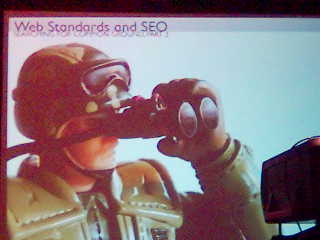- Aaron Gustafson: Sr Web Designer/Dev, Easy! Designs LLC
- Ed Shull: CEO, USWeb (Web marketing)
- Eric Meyer: Complex Spiral Consulting, Standards Nazi
- Andy Hagans: works in SEO, blogs at Performancing.com
white hat vs. black hat SEO
Shull:
- cloaking (visible only to search engine)
- linkspamming
- comment spamming
- hiding tables in javascript to make the content show up higher in results (“cheating?”)
Meyer:
- blackhat is anyone who’s cheating
- sneaky techniques… at least grayhatting
- I’m asked too speak at search engine conferences for reasons I don’t understand. At one
- I was spammed in person on the conference floor
Hagans:
As an SEO I make it my business to know all the weapons in the arsenal. Search engines are getting smarter, so the business case for blackhat getting weaker. I don’t like to get into the moral argument… its gets kind of old.
Professional SEO involves regular testing and writing software. In the long run blackhat doesn’t make sense: you’ll get caught and penalized. Accessibility and web standards = whitehat SEO already.
Copywriting and SEO
Gustafson:
Good content for the page, semantic markup all help.
Shull:
We work with a lot of publishers (example: Forbes). Copy is the thing. Every title on their page said “Forbes.com.” They were excited to learn they could change it, but they just wanted “Forbes.com: The capitalist tool.” We got them to put the article names up there.
When the Hummer H3 coming out, we let our clients know about search terms coming up in their space. The Forbes article title was “Baby Hummer” which didn’t help them with “Hummer H3.” Instead of “Martha Stewart Goes to Prison,” “Stewart Goes to Prison” [so we had to get them to use better descriptive titles on the web pages].
Meyer:
The role of copywriting is to get people to like the site and link to it.
Hagans:
I agree: being linkable more important than the code. Re copywriting, you need to understand usability, accessibility, and SEO as well as marketing. Use alt text. Don’t use “click here.”
Meyer:
The alt attribute is important. Title is most often used for snarky comments.
Hagans:
Linking algorithms have killed most of the old tricks. Using common structural elements: h1, good link anchors are the most important things.
Question: Better to use h1 for name of site or page/article title?
Answer: The title.
Descriptive page titles, good navigation, good anchor text
Someone (I forget who):
Personally, I love site maps. another way to make sure every page on your site has a link into it
Google allows you to upload an xml version of your sitemap.
Microformats
Meyer:
Microformats have a whole lot of potential, not yet a lot of payoff. One example, link rel=”license”, Yahoo has a Creative Commons search that looks for that rel attribute/value.
In the works: hresume. Would enable, for example, a search among resumes of people Jeffrey Zeldman regards as friends
Shull:
You can use SEO as a way to sell web standards.
Hagans:
Getting to 508 helps, but after that you don’t get much. Still, it’s important to get the low-hanging fruit.
Question: Clients view SEO as a different project. How do you explain to them that it’s inherent in good web design?
Answer: Educate them.
Mention of Matt Cutts, Google search engineer who outs black hats on his blog.
tags: sxsw2006, sxsw

